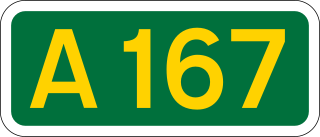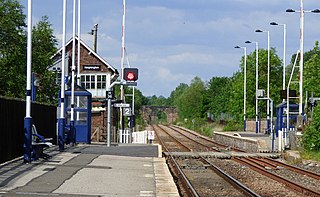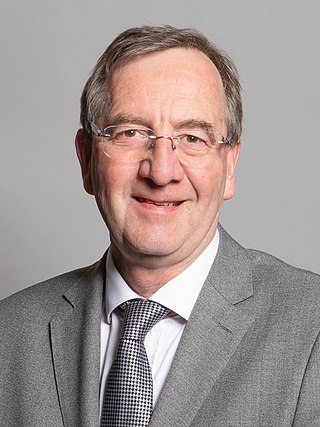
County Durham, officially simply Durham (/ˈdʌrəm/), is a ceremonial county in North East England. The county borders Northumberland and Tyne and Wear to the north, the North Sea to the east, North Yorkshire to the south, and Cumbria to the west. The largest settlement is Darlington.

Sedgefield District was, from 1974 to 2009, a local government district and, borough in County Durham, in North East England. It had a population of about 87,000. It was named after Sedgefield, but its largest town was Newton Aycliffe. Other places included Shildon, Ferryhill and Spennymoor.

Ferryhill is a town in County Durham, England, with an estimated population in 2018 of 9,362. The town grew in the 1900s around the coal mining industry. The last mine officially closed in 1968. It is located between the towns of Bishop Auckland, Newton Aycliffe, Sedgefield, Shildon, Spennymoor and the cathedral city of Durham.

The A167 and A167(M) is a road in North East England. It is partially a trunk road and partially a motorway, where it is commonly referred to as Newcastle Central Motorway. Most of the road’s route was formerly that of the A1, until it was re-routed with the opening of the A1(M) in the 1960s.

Aycliffe Village is a village in County Durham, in England. It is situated immediately to the south of the town of Newton Aycliffe.

School Aycliffe is a village and former civil parish, now in the parish of Great Aycliffe, in the County Durham district, in the ceremonial county of Durham, England. It is a short distance west of Newton Aycliffe, and east of Heighington. Its name derives from a Viking called Scula, who owned land in that part of South Durham.
Heighington is a village in the borough of Darlington and ceremonial county of County Durham, England. The population of the civil parish at the 2011 census was 2,395. It is situated between Darlington and Shildon, near Newton Aycliffe. One of its most significant features is St Michael's Church, which sits in the middle of a large village green. The church is Norman, except for the 13th-century south aisle and the 19th-century north aisle. A rare feature in this church is a pre-Reformation oak pulpit with six traceried linen fold panels, with an inscription bearing prayers for its donor: an Alexander Flettcher and his wife Agnes.

Sedgefield is a constituency in County Durham represented in the House of Commons of the UK Parliament since 2019 by Paul Howell of the Conservative Party. It elects one Member of Parliament (MP) by the first past the post system of election.

Bishop Auckland is a constituency in County Durham represented in the House of Commons of the UK Parliament since 2019 by Dehenna Davison, a Conservative.

The Tees Valley Line is a rail route, in Northern England, following part of the original Stockton and Darlington Railway route of 1825. The line covers a distance of 38 miles (61 km), and connects Bishop Auckland to Saltburn via Darlington, Middlesbrough and 14 other stations in the Teesdale.

Heighington is a railway station on the Tees Valley Line, which runs between Bishop Auckland and Saltburn via Darlington. The station, situated 5 miles 62 chains (9.3 km) north-west of Darlington, serves the villages of Aycliffe and Heighington in County Durham, England. It is owned by Network Rail and managed by Northern Trains.

The River Skerne is a tributary of the River Tees. It flows through County Durham in England.
Heighington CE Primary School is a Church of England primary school with academy status located in the village of Heighington, near Newton Aycliffe, County Durham. As of 2016 it educated 279 pupils aged 4–11. At its Ofsted inspection in 2019, it was classed as a ‘good’ school. The headmaster since 1995 has been Neil Parker.

Paul Howell is a British Conservative Party politician serving as Member of Parliament (MP) for Sedgefield since 2019. Prior to his political career, he was an accountant.

County Durham is a local government district in the ceremonial county of County Durham, England. It is governed by Durham County Council, a unitary authority. The district has an area of 2,232.6 km2, and contains 135 civil parishes. It forms part of the larger ceremonial county of Durham, together with boroughs of Darlington, Hartlepool, and the part of Stockton-on-Tees north of the River Tees.
The county of Durham has returned 7 MPs to the UK Parliament since 1983. Under the Local Government Act 1972, which came into effect on 1 April 1974, the boundaries of the historic/administrative county were significantly altered with the north-east of the county, comprising more than half the electorate, being transferred to the new metropolitan county of Tyne and Wear. In addition, the borough of Hartlepool was included in the new county of Cleveland. These changes were reflected in the following redistribution of parliamentary seats which did not come into effect until the 1983 general election, resulting in a reduction in the county's representation from 16 to 7 MPs.























